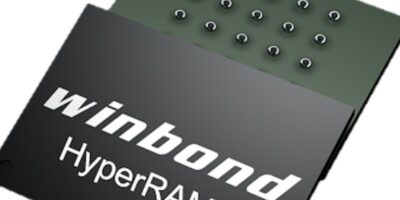Winbond exploits HyperRAM for AIoT
The artificial intelligence of things (AIoT) will consist of automotive electronics, industrial 4.0, and smart home applications, new IoT edge devices and human-machine interface devices, all of which will require new functionality in terms of size, power consumption, and performance. New microcontrollers are being developed to meet these demands with higher performance and lower power consumption and with new RAM options to improve that of the existing SDRAM and pSRAM available.
HyperRAM supports the HyperBus interface and Winbond Electronics offers 32, 64 and 128Mbit devices. Hans Liao, technology manager of DRAMs at Winbond, explained that the computing power, data processing and image display functions of traditional MCUs are limited and that the new IoT devices often have touch panel as image control interface, or require stronger edge computing functions for image processing and speech recognition, requiring higher performance, lower power microcontrollers.
Winbond’s 64Mbit HyperRAM consumes 90 microW at 1.8V, which is about half of a DRAM of the same capacity, claims the company. The power consumption of HyperRAM is only 45 microW at 1.8V in hybrid sleep mode – as opposed to the standby mode of an SDRAM. A low power SDRAM has a larger form factor than HyperRAM, says Winbond.
In addition, HyperRAM has only 13 signal pins, which can greatly simplify the PCB layout design. It also means that when designing end products, developers can use microcontrollers with more pin-out for other purposes or use microcontrollers with fewer pins for cost-effectiveness.
Simplifying control interface is another feature of HyperRAM. Based on pSRAM architecture, HyperRAM is a self-refresh RAM. It can automatically return to standby mode. This means system memory is easier to use, and the development of firmware and drivers is also simplified, says Winbond.
Winbond’s HyperRAM is based on a 38nm process node, which will continue to move toward 25nm, confirms Winbond.
Winbond’s entry to the HyperRAM camp makes it the third supplier, in addition to Cypress and ISSI. Its 32Mbit device has entered mass production, the 64 and 128Mbit are expected to enter mass production in 4Q19 and 1Q20 respectively. Products of 24BGA (automotive grade), 49BGA and KGD are available. The size of 24BGA is 6.0 x 8.0mm2, while the 49BGA is only 4.0 x 4.0mm2, which targets the consumer wearable market.




